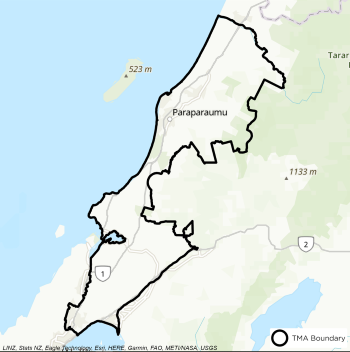Kāpiti-Wellington TB Management Area (TMA)
Pest control work planned for Kāpiti-Wellington includes wildlife surveillance.
Eradicating bovine TB in NZ
As part of our TBfree programme we deliver our pest control operations through a framework of TB management areas (TMAs). TMAs are areas with known TB infection in livestock or wildlife. Each TMA has a specific TB control plan designed to eradicate TB as effectively as possible.
 The Kāpiti-Wellington TMA
The Kāpiti-Wellington TMA
Located on the west coast of the southern North Island, this long TMA runs from the suburbs of Wellington and Porirua in the south, to the Ōtaki River in the north. The TMA incorporates coastal flats and hill country. The west boundary is the sea, and the Hutt Valley and the Tararua Range are to the east of the TMA area.
This is a highly populated TMA that includes parts of Porirua, Lower Hutt and Waikanae. In addition to the built-up areas, many lifestyle blocks exist in the TMA area. About 500 herds are in the TMA — 65% are meat production herds and 30% are beef breeding.
History of TB and pest control in Kāpiti-Wellington
Since the late 1990s, the number of infected cattle herds in this TMA has been low. Sporadic possum control in this period suppressed infected herd numbers, but wouldn’t have been enough to achieve TB freedom in possums. The focus of our possum control more recently has been to provide a buffer between the area where TB-infected wildlife can be found, and the intensively farmed area to the north. We've caught 7 TB-infected pigs since 2012.
Previous possum control and livestock disease management has reduced the number of infected herds in the Wellington region. However, our monitoring has shown that we need to do further control work in the Kāpiti-Wellington area to reduce the possum population. This will:
- minimise the risk of the disease spreading through wild animal populations into farmed cattle and deer
- ensure further good progress towards eradicating TB.
We last completed:
- ground control in Moonshine in 2016/2017
- pig surveys in Kāpiti, Kāpiti Buffer, Moonshine and Pukerua Bay in 2024/2025.
The Kāpiti and Pukerua Bay areas have had no TB possum control to date. In 2022, we began pig surveillance in these areas to assess whether TB is present in the local wildlife, and decide if we need to do possum control.
Current state
As of June 2025, there are no infected herds in the Kāpiti-Wellington TMA.
Future pest control operations
We plan our pest control operations up to 3 years in advance. The current year runs from July 2025 to June 2026.
Dates and control methods for pest control operations in Kāpiti-Wellington are provisional and subject to change. If you’re affected by any upcoming operations, our pest control contractors will contact you before work begins. They will:
- talk you through the specifics of each operation
- explain what you need to do before the operations start
- get your consent for the work to be done.
| Type of control | When | Coverage | Where |
|---|---|---|---|
| Pig survey | 2025/2026 | 12,986ha | Kapiti-Wellington |
Map of 2025/2026 pest control operations
The proposed area for wildlife surveillance is marked on the map in blue.
Interactive map showing Kāpiti-Wellington TB management area boundaries, Vector Control Zone, and proposed control areas
Contacts
Supplejack Contracting Limited manages eradication activities in the Kāpiti-Wellington TMA. Contact them directly if you have feedback or questions about upcoming operations.
Supplejack Contracting Limited
Phone: 06 378 8414
Email: admin@supplejackcontracting.co.nz
OSPRI
PO Box 3412
Wellington 6140
Phone: 06 353 2710
Email: vector.sni@ospri.co.nz

